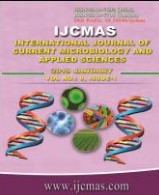


 National Academy of Agricultural Sciences (NAAS)
National Academy of Agricultural Sciences (NAAS)

|
PRINT ISSN : 2319-7692
Online ISSN : 2319-7706 Issues : 12 per year Publisher : Excellent Publishers Email : editorijcmas@gmail.com / submit@ijcmas.com Editor-in-chief: Dr.M.Prakash Index Copernicus ICV 2018: 95.39 NAAS RATING 2020: 5.38 |
The present investigation was carried out with 32 diverse genotypes of bread wheat in completely randomized block design with 3 replications at Norman E. Borlaug Crop Research Centre, G.B. Pant University of agriculture & Technology Pantnagar for screening the genetic diversity for yield and physiological traits under normal sown condition. The observations were recorded on 16 agronomic traits and 3 physiological traits. The statistical analysis for genetic divergence was done using Mahalanobis-D2 statistics and clustering of genotypes was done using Tocher method. On the basis of genetic diversity analysis, it was found that the maximum percent contribution towards genetic divergence was from grain yield and minimum by harvest index and spikelet number per spike. Clustering of genotypes revealed that cluster-II has maximum number of genotypes (13) and clusters IV, V and VI each has single genotype only. The highest intra-cluster distance was exhibited by cluster-III (583.84) revealing maximum genetic divergence among its constituents. The highest inter-cluster distance was found between clusters V and VI (1924.88) and the lowest was between cluster-I and II (410.95). Cluster-I exhibited highest cluster means for most of the agronomic traits like grain weight per spike, biological yield per plant and grain yield per plot while clusters-IV and V revealed highest cluster means for physiological traits like canopy temperature depression and SPAD (chlorophyll content) value. The genotypes bearing the desired values from different clusters can be exploited in future breeding programme for the improving the wheat genotypes for yield and physiological traits.
 |
 |
 |
 |
 |